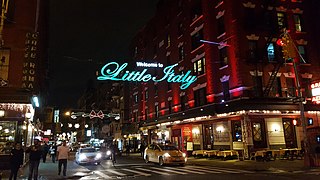Little Italy, Manhattan
| Little Italy | |
|---|---|
| Neighborhood in Manhattan | |

This sign is found on Mulberry Street, near Broome St in Little Italy
|
|
| Coordinates: 40°43′09″N 73°59′50″W / 40.719141°N 73.997327°WCoordinates: 40°43′09″N 73°59′50″W / 40.719141°N 73.997327°W | |
| Country |
|
| State |
|
| City |
|
| Borough | Manhattan |
Little Italy is a neighborhood in lower Manhattan, New York City, once known for its large population of Italian Americans. Today the neighborhood consists of only a few Italian stores and restaurants. It is bounded on the west by Tribeca and Soho, on the south by Chinatown, on the east by the Bowery and Lower East Side, and on the north by Nolita.
Little Italy on Mulberry Street used to extend as far south as Worth Street, as far north as Houston Street, as far west as Lafayette Street, and as far east as Bowery. It is now only three blocks on Mulberry Street. Little Italy originated as Mulberry Bend. Jacob Riis described Mulberry Bend as "the foul core of New York’s slums." During this time period "Immigrants of the late 19th century usually settled in ethnic neighborhood". Therefore, the “mass immigration from italy during the 1880’s” led to the large settlement of Italian immigrants in lower manhattan. The results of such migration had created an "influx of Italian immigrants" which had "led to the commercial gathering of their dwelling and business".
Bill Tonelli from New York magazine said, "Once, Little Italy was like an insular Neapolitan village re-created on these shores, with its own language, customs, and financial and cultural institutions." Little Italy was not the largest Italian neighborhood in New York City, as East Harlem (or Italian Harlem) had a larger Italian population. Tonelli said that Little Italy "was perhaps the city’s poorest Italian neighborhood". In 1910 Little Italy had almost 10,000 Italians; that was the peak of the community's Italian population. At the turn of the 20th century over 90% of the residents of the Fourteenth Ward were of Italian birth or origins. Tonnelli said that it meant "that residents began moving out to more spacious digs almost as soon as they arrived." Such a vastly gowing community impacted the "U.S. labor movement in the 20th century” by making up much of the labor population in the garment industry".
...
Wikipedia

